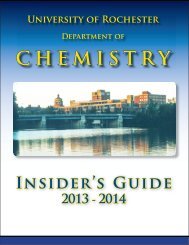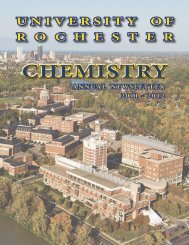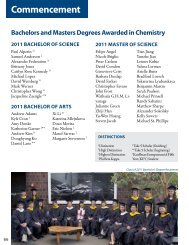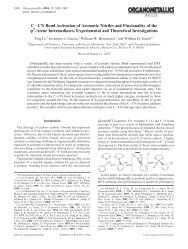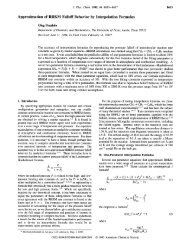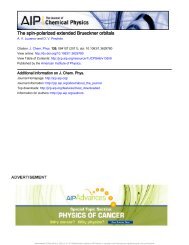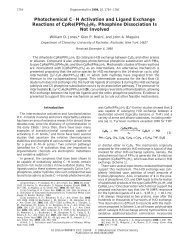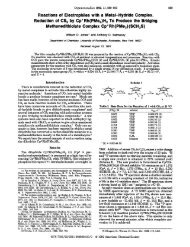Synthesis and Reactivity of New Ni, Pd, and Pt 2, 6-Bis (di-tert ...
Synthesis and Reactivity of New Ni, Pd, and Pt 2, 6-Bis (di-tert ...
Synthesis and Reactivity of New Ni, Pd, and Pt 2, 6-Bis (di-tert ...
Create successful ePaper yourself
Turn your PDF publications into a flip-book with our unique Google optimized e-Paper software.
Inorganic Chemistry<br />
<strong>Synthesis</strong> <strong>of</strong> [(PONOP)<strong>Pd</strong>Cl]Cl 3 CH 2 Cl 2 (2b). In a 500 mL<br />
Schlenk flask PONOP lig<strong>and</strong> (500 mg, 1.25 mmol), <strong>Pd</strong>Cl 2 (NCCH 3 ) 2<br />
(324 mg, 1.25 mmol), <strong>and</strong> 100 mL <strong>of</strong> anhydrous CH 2 Cl 2 were<br />
combined under a nitrogen atmosphere. The reaction mixture was<br />
stirred at room temperature for 60 min. The volatiles were removed<br />
under vacuum (overnight), leaving a light yellow solid which was washed<br />
with hexane <strong>and</strong> benzene <strong>and</strong> dried under vacuum yiel<strong>di</strong>ng complex 2c<br />
(87%). When this reaction was carried out in CH 3 CN as solvent, some<br />
decomposition <strong>of</strong> the PONOP lig<strong>and</strong> was observed.<br />
1 H NMR (500<br />
MHz, CD 3 OD): δ 8.28 (t, J H H = 8.3 Hz, 1H), 7.28 (d, J H H = 8.5 Hz,<br />
2H), 2.01(s, 2H), 1.57 (vt, J P H = 8.0 Hz, 36H).<br />
13 C{ 1 H} NMR<br />
(100 MHz, CD 2 Cl 2 ): δ 163.8 (s), 150.9 (s), 106.7 (s), 42.3 (t, J P C =<br />
5.2 Hz), 27.5 (t, J P C = 2.5 Hz). 31 P{ 1 H} NMR (162 MHz, CD 2 Cl 2 ):<br />
δ 192.6 (s). Anal. Calcd (found) for C 22 H 41 Cl 4 NO 2 P 2 <strong>Pd</strong>: % C, 39.93<br />
(40.25); % H, 6.24 (6.32); % N, 2.12 (2.13).<br />
[(PONOP)<strong>Pd</strong>Cl]Cl (3b). In a 500 mL Schlenk flask complex 2b<br />
(500 mg) <strong>and</strong> 100 mL <strong>of</strong> THF were combined under a nitrogen atmosphere.<br />
The mixture was sonicated for 2 h <strong>and</strong> then THF was removed<br />
by cannula leaving the solid at the bottom <strong>of</strong> the flask. A 100 mL portion<br />
<strong>of</strong> hexane was added, <strong>and</strong> the solid sonicated again for 2 h. Hexane was<br />
removed by cannula leaving the solid at the bottom <strong>of</strong> the flask. The solid<br />
was dried overnight under vacuum yiel<strong>di</strong>ng pure complex 3b (83%). 1 H<br />
NMR (400 MHz, CD 2 Cl 2 ): δ 8.65 (t, J H H = 7.6 Hz, 1H), 7.28 (d, J H H =<br />
8.0 Hz, 2H), 1.50 (vt, J P H = 8.0 Hz, 36H). 13 C{ 1 H} NMR (100 MHz,<br />
CD 2 Cl 2 ): δ 163.8 (s), 150.9 (s), 106.7 (s), 42.3 (t, J P C = 5.2 Hz), 27.5<br />
(t, J P C = 2.5 Hz). 31 P{ 1 H} NMR (162 MHz, CD 2 Cl 2 ): δ 192.6 (s).<br />
(H-PONOP)<strong>Pd</strong>Cl (4b). In a 250 mL Schlenk flask, complex 3b<br />
(100 mg, 0.17 mmol) <strong>and</strong> 70 mL <strong>of</strong> pentane were combined under a<br />
nitrogen atmosphere. A 0.17 mL portion <strong>of</strong> LiHBEt 3 (0.17 mmol, 1 M in<br />
THF) was added dropwise at room temperature. The reaction mixture<br />
was stirred at room temperature for 20 min. The solution was filtered<br />
under a nitrogen atmosphere using a cannula, <strong>and</strong> the volatiles were<br />
removed under vacuum yiel<strong>di</strong>ng complex 4b (79%). Crystals <strong>of</strong> complex<br />
4b were grown by slow evaporation from a benzene solution. Complex<br />
4b was more stable than 4c <strong>and</strong> slowly decomposed after a few days in<br />
solution. 1 H NMR (400 MHz, C 6 D 6 ): δ 4.18 (t, J H H = 2.8 Hz, 2H),<br />
3.37 (t, J H H = 3.2 Hz, 2H), 1.34 (vt, J P H = 7.6 Hz, 36H). 13 C{ 1 H}<br />
NMR (125 MHz, C 6 D 6 ): δ 159.7 (s), 71.3 (t, J P C = 4.4 Hz), 39.8<br />
(t, J P C = 7.8 Hz), 26.9 (s), 25.1 (s). 31 P{ 1 H} NMR (162 MHz, C 6 D 6 ):<br />
δ 173.1 (s).<br />
Attempted <strong>Synthesis</strong> <strong>of</strong> (H-PONOP)<strong>Pd</strong>H (5b). In a 100 mL<br />
Schlenk flask, complex 4b (50 mg, 0.09 mmol) <strong>and</strong> 10 mL <strong>of</strong> pentane<br />
were combined under a nitrogen atmosphere. A 0.09 mL portion <strong>of</strong><br />
LiHBEt 3 (0.09 mmol, 1 M in THF) was added dropwise at room<br />
temperature. The reaction mixture was stirred at room temperature <strong>and</strong><br />
monitored by 31 P NMR spectroscopy over time. No <strong>Pd</strong> H complex was<br />
observed. With longer stirring times complex 4b slowly decomposed.<br />
From the decomposed mixture, one compound was isolated as crystalline<br />
solid, [<strong>Pd</strong>(μ-Cl)( t Bu 2 PO 333 H 333 OP t Bu 2 )] 2 (Figure 9), which is a<br />
known catalyst for the cross-coupling reactions <strong>of</strong> vinyl <strong>and</strong> aryl<br />
chlorides with arylboronic acids, arylzinc reagents, <strong>and</strong> thiols. 14,21<br />
<strong>Synthesis</strong> <strong>of</strong> [(PONOP)<strong>Pt</strong>Cl]Cl 3 CH 3 CN (2c). In a 500 mL<br />
Schlenk flask, PONOP (500 mg, 1.25 mmol), <strong>Pt</strong>Cl 2 (NCPh) 2 (534 mg,<br />
1.25 mmol), <strong>and</strong> 100 mL <strong>of</strong> anhydrous CH 3 CN were combined under<br />
a nitrogen atmosphere. The reaction mixture was stirred at room<br />
temperature for 30 min. The volatiles were removed under vacuum<br />
(overnight), leaving a white solid which was washed with hexane <strong>and</strong><br />
benzene <strong>and</strong> dried under vacuum yiel<strong>di</strong>ng complex 2c (84%). 1 H NMR<br />
(400 MHz, CD 2 Cl 2 ): δ 8.67 (t, J H H = 8.4 Hz, 1H), 7.32 (d, J H H =<br />
8.0 Hz, 2H), 1.98 (s, 3H), 1.11 (vt, J P H = 8.0 Hz, 36H). 13 C{ 1 H} NMR<br />
(100 MHz, CD 3 CN): δ 164.0 (t, J P C = 5.5 Hz), 148.3 (s), 106.3 (s),<br />
42.4 (t, J P C = 9.4 Hz), 27.0 (t, J P C = 2.5 Hz).<br />
31 P{ 1 H} NMR<br />
(162 MHz, CD 3 CN): δ 175.0 (s, J <strong>Pt</strong> P = 2535 Hz). Anal. Calcd (found)<br />
ARTICLE<br />
Figure 9. X-ray structure <strong>of</strong> the decomposition product [<strong>Pd</strong>(μ-Cl)-<br />
( t Bu 2 PO 333 H 333 OP t Bu 2 )] 2 . Ellipsoids are shown at the 50% level.<br />
for C 23 H 42 Cl 2 N 2 O 2 P 2 <strong>Pt</strong>: % C, 39.10 (39.20); % H, 5.99 (5.95); % N,<br />
3.96 (3.76).<br />
[(PONOP)<strong>Pt</strong>Cl]Cl (3c). In a 500 mL Schlenk flask, complex 2c<br />
(500 mg) <strong>and</strong> 100 mL <strong>of</strong> THF were combined under a nitrogen atmosphere.<br />
The mixture was sonicated for 2 h, <strong>and</strong> then THF was removed<br />
by cannula while the solid remained at the bottom <strong>of</strong> the flask. A 100 mL<br />
portion <strong>of</strong> hexane was added, <strong>and</strong> the solid sonicated again for 2 h.<br />
Hexane was removed by cannula leaving solid at the bottom <strong>of</strong> the flask.<br />
The solid was dried overnight under vacuum yiel<strong>di</strong>ng pure complex 3c<br />
(83%). The 1 H, 13 C, <strong>and</strong> 31 P NMR spectra <strong>of</strong> complex 3c were very<br />
similar to those <strong>of</strong> complex 2c, except for the absence <strong>of</strong> a bound CH 3 -<br />
CN resonance. 1 H NMR (500 MHz, CD 3 OD): δ 8.32 (t, J H H = 8.0 Hz,<br />
1H), 7.29 (d, J H H = 8.0 Hz, 2H), 1.55 (vt, J P H = 8.0 Hz, 36H).<br />
13 C{ 1 H} NMR (100 MHz, CD 3 CN): δ 164.0 (t, J P C = 5.5 Hz), 148.3<br />
(s), 106.3 (s), 42.4 (t, J P C = 9.4 Hz), 27.0 (t, J P C = 2.5 Hz). 31 P{ 1 H}<br />
NMR (162 MHz, CD 3 CN): δ 175.0 (s, J <strong>Pt</strong> P = 2535 Hz). Anal. Calcd<br />
(found) for C 21 H 39 Cl 2 NO 2 P 2 <strong>Pt</strong>: % C, 37.90 (38.29); % H, 5.91 (5.85);<br />
% N, 2.10 (2.31).<br />
(H-PONOP)<strong>Pt</strong>Cl (4c). In a 250 mL Schlenk flask, complex 3c<br />
(100 mg, 0.15 mmol) <strong>and</strong> 70 mL <strong>of</strong> pentane were combined under a<br />
nitrogen atmosphere. A 0.15 mL portion <strong>of</strong> LiHBEt 3 (0.15 mmol, 1 M in<br />
THF) was added dropwise at room temperature. An imme<strong>di</strong>ate color<br />
change from colorless to light yellow was observed. The reaction mixture<br />
was stirred at room temperature for 20 min. The solution was filtered<br />
under a nitrogen atmosphere using a cannula, <strong>and</strong> the volatiles were then<br />
removed under vacuum yiel<strong>di</strong>ng pure light yellow complex 4c (81%).<br />
Complex 4c was not stable in solution, as stirring the solution for 4 h led<br />
to a color change from yellow to colorless because <strong>of</strong> decomposition.<br />
Crystals <strong>of</strong> complex 4c were grown by slow evaporation from a benzene<br />
solution. 1 H NMR (400 MHz, C 6 D 6 ): δ 4.24 (t, J H H = 3.0 Hz, 2H),<br />
3.44 (t, J H H = 3.4 Hz), 1.33 (vt, J P H = 7.6 Hz, 36H). 13 C{ 1 H} NMR<br />
(100 MHz, C 6 D 6 ): δ 159.4 (s), 70.8 , 40.8 (t, J P C = 12.1 Hz), 27.8<br />
(t, J P C = 2.5 Hz), 25.6 (s).<br />
31 P{ 1 H} NMR (162 MHz, C 6 D 6 ):<br />
δ 157.9 (s, J <strong>Pt</strong> P = 2799 Hz). Anal. Calcd (found) for C 21 H 40 ClNO 2 P 2 <strong>Pt</strong>:<br />
% C, 39.97 (40.10); % H, 6.39 (6.42); % N, 2.22 (2.43).<br />
Attempted <strong>Synthesis</strong> <strong>of</strong> (H-PONOP)<strong>Pt</strong>H (5c). In a 100 mL<br />
Schlenk flask, complex 4c (50 mg, 0.08 mmol) <strong>and</strong> 10 mL <strong>of</strong> pentane<br />
were combined under a nitrogen atmosphere. A 0.08 mL portion <strong>of</strong><br />
LiHBEt 3 (0.08 mmol, 1 M in THF) was added dropwise at room temperature.<br />
The reaction mixture was stirred at room temperature <strong>and</strong><br />
monitored by 31 P NMR spectroscopy over time. No <strong>Pt</strong> H complex was<br />
observed. With longer stirring times complex 4c decomposed. From the<br />
decomposed mixture, one compound was isolated as crystalline solid,<br />
9450 dx.doi.org/10.1021/ic201102v |Inorg. Chem. 2011, 50, 9443–9453




